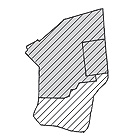The Byzantine Period, 326-638 CE
|

|
During the Byzantine period Jerusalem flourished and experienced an era of prosperity; the city's population grew and many religious buildings were constructed in it. The city's fortifications were probably built after Constantine who focused his construction primarily inside the city. The evidence we have regarding the construction of the city wall and its rehabilitation is from the fifth century CE and is ascribed to the Empress Eudocia (Eudoxia) who was famous for having 'expanded the borders of Jerusalem and reinforcing its walls'.
The route of the wall: In its southern part the line of the wall is identical in many places to that of the wall from the Second Temple period and includes Mount Zion and the hill of the City of David, regions that were inside the city walls until the destruction of the Second Temple (70 CE) and afterward remained outside them. Construction was mostly done along the line of the ancient walls and the Byzantine wall deviated from it in only a few places.
According to tradition the Golden Gate (i.e. the Gate of Mercy) in the eastern wall was built by Heraclius in the year 630 CE in honor of the victory procession that returned the 'Holy Cross' to Jerusalem, which was taken from the Garden Tomb when the Persians conquered the city in 614 CE.
Finds:
Remains of fortifications were discovered along the southwestern side of Mount Zion, next to the Shiloah Pool, on the eastern slope of the City of David, next to the southeastern corner of the Temple Mount, as well as in the northern wall in the vicinity of Damascus Gate and Herod's Gate.
Historical Sources:
The city and its buildings are described in numerous and assorted written sources from the Byzantine period.
"The Shiloah Spring is today located within the city walls because the Empress Eudocia added these walls to the city." (Antonius Martyr, 570 CE, taken from the introduction in D. Bahat 1989).
Jerusalem appears on the Madaba Map as a well-fortified city and there are 6-8 gates that are set in its walls.
Remarks:
Noteworthy among the important buildings that were erected in this period is the Nea Church of the sixth century that was built during the reign of Justinian.
|
|

|
| The city wall in the Byzantine period |

|
| The Madaba Map, sixth century CE
|
|















